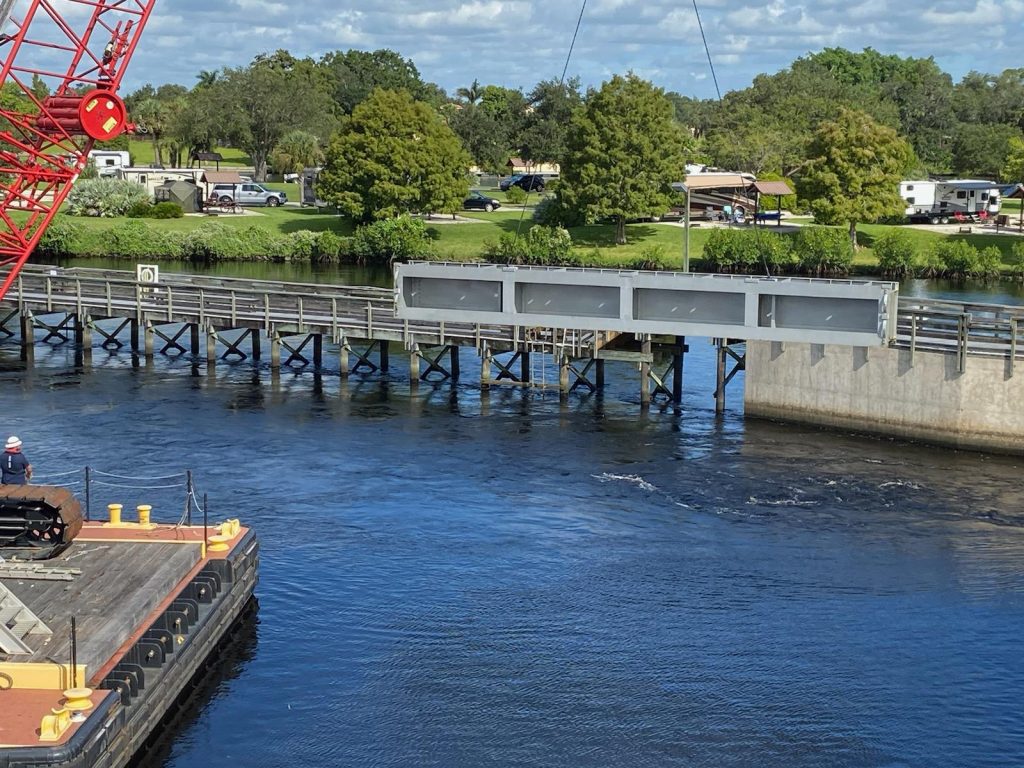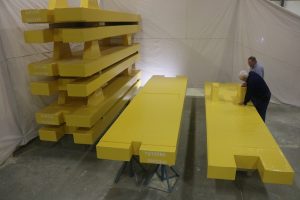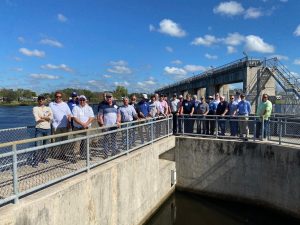

Navigating an Emerging Market
Creative Composites Group shipped 12 GFRP wicket gates from its Augusta, Maine, facility to the Illinois River in March for installation on the Peoria Lock and Dam. Across the country, Orenco Composites in Roseburg, Ore., began work this year on 60 GFRP quoin blocks for lock gates on the Chittenden Lock and Dam in Seattle, with one-third slated for delivery in the fall. These are just two of the inland waterway projects in progress by composites companies for the U.S. Army Corps of Engineers (USACE), which maintains 239 navigation lock chambers.
“The Corps is moving into FRP,” says Robert Germann, PE, technical manager for the South Atlantic Division of the U.S. Army Corps of Engineers. “We’ve got 13,000 steel structures within our navigation and flood risk management portfolios. Based on a 50-year steel design life, we are on the cusp of replacing 260 hydraulic structures a year that were built between 1920 and 1980.”
The USACE started working on composite demonstration projects for large waterborne infrastructure in 2012, when its Engineer Research and Development Center (ERDC) collaborated with West Virginia University to design and build a prototype GFRP wicket gate. In 2015, demonstration gates made from E-glass and vinyl ester resins in a sandwich panel construction were installed on the Illinois River, replacing 12-inch thick, white oak timber gates. The wicket gates, which are a series of flat rectangular panels that can be raised and lowered depending on river conditions, were inspected in 2022 and are performing well.
Since then, the USACE has committed to investing in composite structures where they make sense to meet its new 100-year design life standards.
“We need to take that next step in material science technology and look at products that will live 100 years in adverse weather and environmental conditions,” says Germann.
Early Composite Applications
Composites fit the bill. They are corrosion resistant and low maintenance. Equally important, however, is the cost effectiveness of any material and product selected by the USACE, which is an agency within the Department of Defense and funded by Congress.
“We have limited funds to maintain, repair and operate gates, so we need to use our money wisely,” says Eric Johnson, PE, technical manager for the hydraulic composite structure program at USACE’s Inland Navigation Design Center. “Instead of putting up a steel structure that’s going to corrode and require new paint every 20 years over its life, why not invest in a material that has about the same upfront cost and doesn’t require as much maintenance over its lifetime?”
For one lock and dam location, Germann and his colleagues at the Army Corps compared life cycle costs for three tainter gates – a type of radial arm floodgate – made from steel and composites.
“If we look at a 100-year life cycle for a steel replacement, it will cost $200 million over that life span. If we replace that with FRP, we are looking at $20 million over 100 years – a 10 times savings,” says Germann. “That’s important to taxpayers and to us, so we are looking at how we can leverage those life cycle costs as we grow into an FRP program.”
As it ramps up the program, the USACE is initially looking at low-risk applications. For instance, static loads such as the force of the water pose a low risk, whereas dynamic loads caused by ice jams or a tow barge hitting a gate present a higher risk.
In February, the Corps hosted an outreach event for ACMA members in its Jacksonville District to highlight a low-risk application for conversion to FRP – the W.P. Franklin Lock and Dam on the Caloosahatchee River, Okeechobee Waterway. Approximately 15,000 vessels, mostly recreational, travel through the low-head lock and dam annually.
The quoin blocks that Orenco Composites are fabricating are another example of an ideal early application for fiber reinforced polymer. Quoin blocks are placed on the end of a miter gate (with a convex surface) and the lock wall (with a concave surface) to help ensure continuous contact of the miter gate against the lock wall. Orenco will manufacture 60 blocks in four styles, each approximately 18 inches long and between six and 12 inches wide.
“Locks and dams present a very good opportunity for composites companies,” says Eric Ball, president of Orenco Composites and a member of ACMA’s Board of Directors. “The Army Corps is smart to consider composite materials because the corrosion resistance is so much better than the materials historically used. You could build all these structures out of 316 stainless steel, but it would cost a fortune.”
Extensive FRP Opportunities
Creative Composites Group (CCG) has been working with the USACE since 2015, when its Dayton, Ohio, facility infusion molded three prototype wicket gates. One was delivered to West Virginia University to verify strength and deflection. The others were delivered to the Army Corps’ Rock Island District for demonstration projects on the Illinois River.
“They had a series of wicket gates, putting the FRP ones in line with wood and steel ones,” says Scott Reeve, who is in business development with CCG. “After a year, they pulled them out and inspected the FRP gates.” The FRP gates were performing as expected, so they were placed back in the river.
CCG designed the wicket gates using a wrapped core design to meet bending loads and other requirements. The sandwich structure features a foam core to meet another of the Army Corps’ requirements on this project – buoyancy. The wicket gates reside at the bottom of the river. When they are raised, the foam core helps ease the process.
The foam core is covered by GFRP fabric to create a bidirectional internal grid. “This is the same configuration we use in vehicle bridges and Navy structures,” says Reeve. “It’s a great way to make sandwich structures that are high strength and durable.”
After the success of the demonstration gates, the USACE decided to move to a production version of the wicket gates. It put out an indefinite duration/indefinite quantity (IDIQ) contract for up to 220 wicket gates, with 114 purchased from CCG’s Augusta, Maine, facility.
These wicket gates and the quoin blocks being made by Orenco Composites are not the only ongoing composite projects with the Army Corps. Other contracts that have been awarded or are slated to go out for bid this year include 20-foot-long dewatering bulkhead stoplogs for the Wilmington, N.C., district, a 30-foot x 10-foot wicket gate for the Olmsted Lock and Dam in Kentucky and a 30-foot-high sector gate with a 50-foot radius for a lock near Cape Canaveral, Fla.
The ERDC is developing a roadmap to ascertain all the potential navigation FRP applications. The possibilities are wide-ranging, from trash racks that keep garbage out of the water near locks to guide walls where vessels line up to enter locks.
“We have a lot of timber guide walls, but sometimes the flow conditions aren’t great, and vessels ram into those walls,” says Johnson. “There’s a lot of damage to the walls, and they are hard and expensive to replace. So, we are looking at using FRP pipe piles and beams to replace those timber guide walls.”
Advice for Moving into the Market
Germann and Johnson believe that many companies in the composites industry are poised to work with the Corps.
“Most of our structures hold back water, but they really resemble a bridge turned on its side,” says Johnson. “So, if a company is making pedestrian bridges or other structures like that, then it’s not that a big leap to move into the products we need.”
Here are some high-level considerations:
- Get to know the Corps. “We are an emerging customer for composites companies,” says Germann. “Like any customer, we have our own language and processes. So, companies need to be adaptive and in tune with how we design and contract out our work.”
Keep an eye out at acmanet.org for more opportunities to connect with the USACE like the February event in Florida. You can also sign up for notices of contracts in the market at sam.gov using the keywords “Army Corps of Engineers” and “FRP.”
- Offer education to engineers. While Germann and Johnson are championing the use of FRP within the USACE, engineers at each of its districts may not be as versed with the material. “There are multiple areas and people within the Army Corps that have to become comfortable with composites,” says Reeve.
CCG has held lunch-and-learn events to introduce USACE employees to FRP, share case studies, discuss design and engineering considerations, and more. The Army Corps also began holding design charettes last year for its employees to share information on composite materials and solutions.
- Design for durability. Hota GangaRao, a civil and environmental engineering professor and director of the Constructed Facilities Center at West Virginia University, began designing and building prototypes of composite wicket gates for the Army Corps in 2012. “It’s been a long road, and I would love to see the composites industry take over mass manufacturing of wicket gates,” he says. But he stresses that quality design and production are paramount.
Durability is a key design consideration, says GangaRao. He offers a handful of suggestions for ensuring durability: Account for knock-down factors in the design, use high quality resins that are forgiving in harsh environments, ensure there are no high stress concentrations at re-entrant angles and pay attention to curing to enhance longevity.
- Be prepared to test your products. “With steel, you can use the American Institute of Steel’s construction manual to design a structure. Those books aren’t available yet for composites, and it scares engineers to some degree,” says Alex Thibodeau, director of operations for CCG’s Augusta facility. “That’s why they require mechanical testing.”
When the facility manufactured wicket gates for the Army Corps under its most recent contract, it sent two of them to the company’s Dayton location for tensile, flexural, impact and other testing. The testing was flawless, says Thibodeau. But he cautions composites companies that testing takes time and money.
- Gain experience in resin infusion. “Unless somebody comes up with a new process for large structures, then vacuum infusion is the process to use,” says Thibodeau. “You need to understand the process really well.”
Successful production requires a large facility, good engineering horsepower and experienced fabricators, he adds.
“This is a great opportunity for the entire composites industry,” says Reeve. “The U.S. Army Corps of Engineers is a large customer that has evaluated composites and is moving ahead with the material. We have to make sure we take care of them.”
Susan Keen Flynn is managing editor of Composites Manufacturing magazine. Email comments to sflynn@keenconcepts.net.

Employees at Creative Composites Group’s Augusta, Maine, facility examine GFRP wicket gates prior to shipment to the Peoria Lock and Dam.
Photo Credit: Creative Composites Group

Representatives from 16 companies throughout the composites’ supply chain visited the W.P. Franklin Lock and Dam in February. ACMA’s Composites Growth Initiative sponsored the event.
Photo Credit: ACMA

SUBSCRIBE TO CM MAGAZINE
Composites Manufacturing Magazine is the official publication of the American Composites Manufacturers Association. Subscribe to get a free annual subscription to Composites Manufacturing Magazine and receive composites industry insights you can’t get anywhere else.




